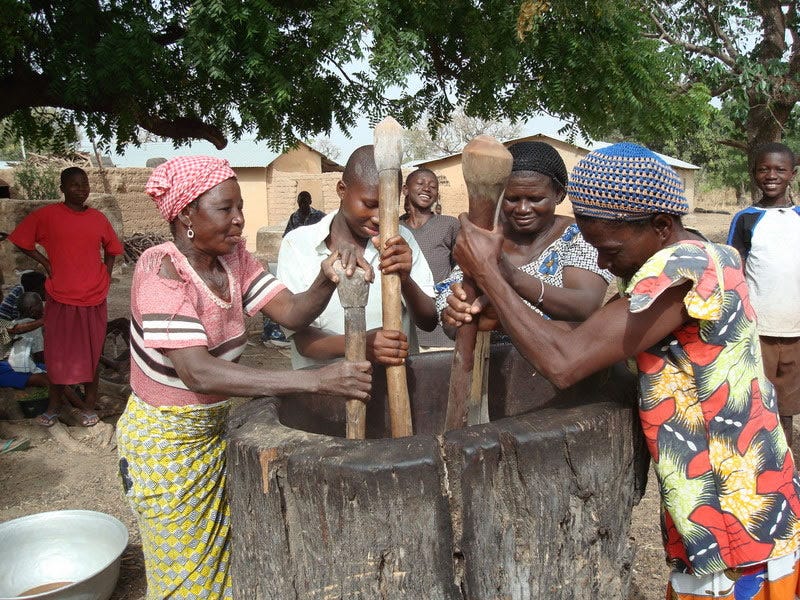It is the White Bagre,
it is Bagre Day:
we begin to teach
the children
and the women
and the men.
We go in again
to the long room.
You see the food,
you see the meat.
It is beer we drink
and make a din.
The many matters to be performed in the room,
we recited them and completed all.
And now we turn again
to take the food.
We have eaten.
Ancestors, you have eaten.
Guardians, you have eaten.
Deities, you have eaten.
Together, you have eaten.
(White Bagre, 4860 – 4880)
This week’s episode focuses on the last two ceremonies of the White Bagre: the Bagre Gyingyiri (“gyingyiri” refers to the tired way people dance on the last day of the Bagre, a typical African ideophone), and the Bagre Bells when the neophytes are given special bells used to communicate with the supernatural world.
(You can read both the White and Black Bagre, as well as extensive commentary on both versions and Dagaaba society as a whole in Jack Goody’s “The Myth of the Bagre.”)
Writing about the place of the Bagre in Dagaaba society, Jack Goody states:
“If the initial reasons for joining are largely medical, the reasons for continuing to participate are mainly social. Each grade of membership has various duties, and progression through the society is a matter of some pride to the individual. The performance of the ceremonies themselves, the food, the beer, the music, the throng of dancers, the subjection of the neophytes to ordeals through which one has successfully passed — all is a source of pleasure to the initiated. People aim to perform the main part of the ceremony when the moon is full, for the dancing is a special feature of the rites. The senior spectators sit round and drink from the large pots of beer, while the younger ones dance. For all it is a time of relaxation and enjoyment. Men and women will sit on the rooftop conversing and drinking beer, simultaneously out of the same gourd if they are on friendly terms, while the young use dancing as a means of courtship.” (p. 41)

The image this section of the Dagaaba White Bagre brings to my mind – that of a community gathered to learn about and reflect on what matters to them, test the mettle of their young, and feast together – comes from the memory of a foggy Sunday in Buea, my hometown. After morning mass, a group of us adolescent boys and girls, along with some older teenagers and adults, gathered in one of the large classrooms of the nearby Catholic School Buea Town. It was the final day of instruction and discussion led by women of the Catholic Women’s Association and teachers from various Catholic schools in the diocese. We hadn’t gathered to learn about Catholic doctrine, however. We were there for sex education. In the previous days, we’d gathered similarly for talks, skits, demonstrations and learning exercises all aimed at teaching us about the facts about and implications of our maturing bodies. I’d observed some of my male peers wrestle with the reality and implications of menstruation, even as us girls averted our gazes and hid our discomfort behind placid smiles. I’d watched a family friend, a dignified woman who worked as a justice of the courts, patiently and determinedly, against a backdrop of snickers, explain to an earnest teenage boy why wet dreams are a normal part of growing up. I’d noticed a sense of camaraderie bloom among us participants, an ease and playfulness which seemed to soften the stiffness that can show up with increasingly bass heavy voices and budding breasts. More than once, I’d caught a glint of mischievous enjoyment in the eyes of the younger adult instructors as they watched us squirm under the weight of their scrutiny, noting who didn’t seem shocked by the information being revealed. I remember the meals we ate together, the games we played, the quizzes and other friendly competition, the singing and the laughter. I remember the way the adults, most of them authority figures in our lives and in the community, seemed more like big friends we were spending time with during those sessions. Above all, I remembered that moment when, after taking it all in, belly full of meat pies and Fanta Orange, I felt a warm buzz in my chest, a honey-sweet feeling of contentment and connection I’ve come to realize shows up when I am feeling particularly attuned to, and in sync with the people I am with.
Regretfully, this event did not continue in subsequent years so by the time most of us were young adults ourselves, we’d pretty much absorbed and adjusted to the prevailing attitudes toward sex in our wider community. What struck me about those sessions, however, and what has remained with me since, was that it was the first time that all members of my community: men, women and children, had come together in such a manner. It was the first time I’d witnessed a sincere collective effort to share important (non-academic or religious) knowledge and promote wellbeing among us the children.
I’m thinking of the Bagre this week, as I reflect on three essays. The first is a reflection by Jewish Rabbi Zohar Atkins on ex-Muslim, and now ex-atheist activist Aayan Hirsi Ali's conversion to Christianity. The second, by writer, film maker and atheist Jake Klein, is an essay which could be summarized in this one statement:
“I believe that when you’re trying to sail across an ocean, you don’t attach yourself to a sinking ship just because it’s always sailed well in the past. You build a new ship, keeping everything that worked about the old one while removing the design flaws that caused it to sink.”
The third is Ayaan Hirsi Ali’s essay itself, in which she describes her journey from trusting young Muslima, to vigorous atheist and activist against Islamic and any other religious extremism, to Christian. In the essay, she argues that we can’t fight off the formidable forces she and many others believe are threats to Western civilization (authoritarianism, Islamic extremism and wokeness) unless we can answer the question: what is it that unites us?
The Bagre society, like world religions, political organizations and many other such organizations around the world, both religious and secular, positions itself as a unifying mechanism, offering a way for people to come together and grapple with the changing dynamics of human existence, more effectively relate with the forces (supernatural or otherwise) which govern their worlds, receive support in times of difficulty, and live more meaningful lives. Quite often, organizations like the Bagre society, much like the “comms” of N.K. Jemisin’s Broken Earth Trilogy, offer a place of refuge, solid ground from which one might ride out the turbulence of ideological tectonic plates grinding up against each other. In his book, Jack Goody notes that towns with Bagre societies seemed more ‘integrated’, in general but especially in how they made political decisions, both under party politics as well as under colonial rule, and in their resistance to missionary influence.
In the Bagre, I find the Dagaaba people’s attempt to weave, mend and adorn their cultural fabric, and find ways to adapt it to the world as they experienced it. Is the Bagre a perfect system? By no means. Matter of fact, in an acutely self-aware exchange, a segment of the Black Bagre, reserved for advanced members, focuses on the suffering caused by errors made by ancestors who were led astray by one of the “Konton (AKA beings of the wild.) The errors persisted because they became tradition and “…when an elder is in trouble, you don’t forsake him.” The resolution of this metaphysical crisis is one of the functions of the Bagre society.
Is the Bagre (or any spiritual or political ideology or organization for that matter) the answer to the question of what unites us? The way to win a civilizational war? I don’t know. What I do know is that however one chooses to answer that question, the response must include ways to meaningfully strive together, opportunities to go in the long room and teach the children and the women and the men, and occasions to feast together so that belly full, we might be able to sit down together to identify and honestly assess how and why the threads of our connection to others and the planet have unraveled, frayed and/or cut. It must include a willingness to work at weaving it all back together, accepting that sometimes, the holes, loose seams and frayed edges are exactly what makes a garment comfortable.
Listen to Part 1 here.
Listen to Part 2 here.













Share this post